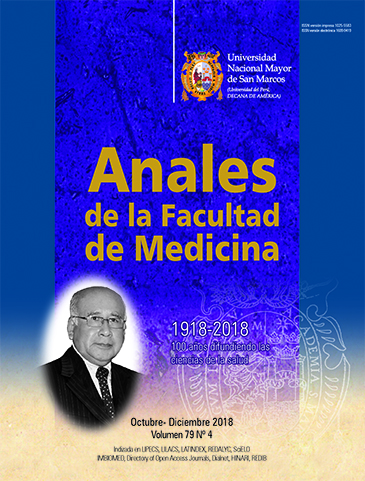Partial transplantation of trachea with preservation of vascular supply: experimental study with and without immunosuppression in animal models
DOI:
https://doi.org/10.15381/anales.v79i4.15630Keywords:
Transplantation, Trachea, Rabbits, ImmunosuppressionAbstract
Introduction. Prolonged tracheal intubation can cause stenosis. In extensive lesions, they have performed transplants or prosthesis placement without good results. Transplantation frequently evolves with necrosis, delayed healing, and ischemia. The anterior segment of the tracheal wall was transplanted to preserve the vascular supply of the trachea. Objectives. Verify that the transplant of a previous patch of the trachea, allows to expand the tracheal lumen in its anterior part and overcome the problems derived from the complete transplant or the insertion of prosthesis and evaluate the viability, macroscopic and microscopic changes of the transplant in two groups of rabbits, one of which will receive treatment with immunosuppressants. Methods. Experimental, prospective, randomized and controlled study. We used 15 rabbits of exocriated strains. In 5, autotransplantation was performed to standardize the surgical technique. In 10, an alotransplant of the anterior wall of the trachea was performed, 5 of which were administered ciclosporin. Euthanasia was performed 15 days postoperatively, for macro and microscopic study. Results. All rabbits evolved satisfactorily. There was no significant difference between those who received immunosuppression and those who did not receive it, when loss of epithelium, granulation tissue, lymphocyte infiltration and fibroproliferation was evaluated. If there was luminal occlusion due to inflammatory causes. When evaluating vascular hyalinosis, vascular stricture, endothelitis and lymphangiectasis there was no significant difference. In none was tissue necrosis found. There were numerous permeable capillaries in the transplanted segment and conservation of the epithelium. Conclusions. The segmental transplantation of the anterior wall of the trachea allowed to enlarge the tracheal lumen with vascular preservation of the graft and good viability, macro and microscopic. Postoperative evolution was good in both groups.Downloads
Published
2018-12-30
Issue
Section
Artículo Original
License
Copyright (c) 2018 Anales de la Facultad de Medicina

This work is licensed under a Creative Commons Attribution-NonCommercial-ShareAlike 4.0 International License.
Those authors who have publications with this magazine accept the following terms:
- Authors will retain their copyrights and guarantee the journal the right of first publication of their work, which will be simultaneously subject to Creative Commons Attribution License that allows third parties to share the work as long as its author and its first publication this magazine are indicated.
- Authors may adopt other non-exclusive licensing agreements for the distribution of the version of the published work (eg, deposit it in an institutional electronic file or publish it in a monographic volume) provided that the initial publication in this magazine is indicated.
- Authors are allowed and recommended to disseminate their work over the Internet (eg: in institutional telematic archives or on their website) before and during the submission process, which It can produce interesting exchanges and increase quotes from the published work. (See El efecto del acceso abierto ).
How to Cite
1.
Somocurcio V. JG, Valcárcel S M, Sotomayor E. A, Somocurcio P. JR, Zavaleta J. Partial transplantation of trachea with preservation of vascular supply: experimental study with and without immunosuppression in animal models. An Fac med [Internet]. 2018 Dec. 30 [cited 2025 Jun. 5];79(4):282-7. Available from: https://revistasinvestigacion.unmsm.edu.pe/index.php/anales/article/view/15630



